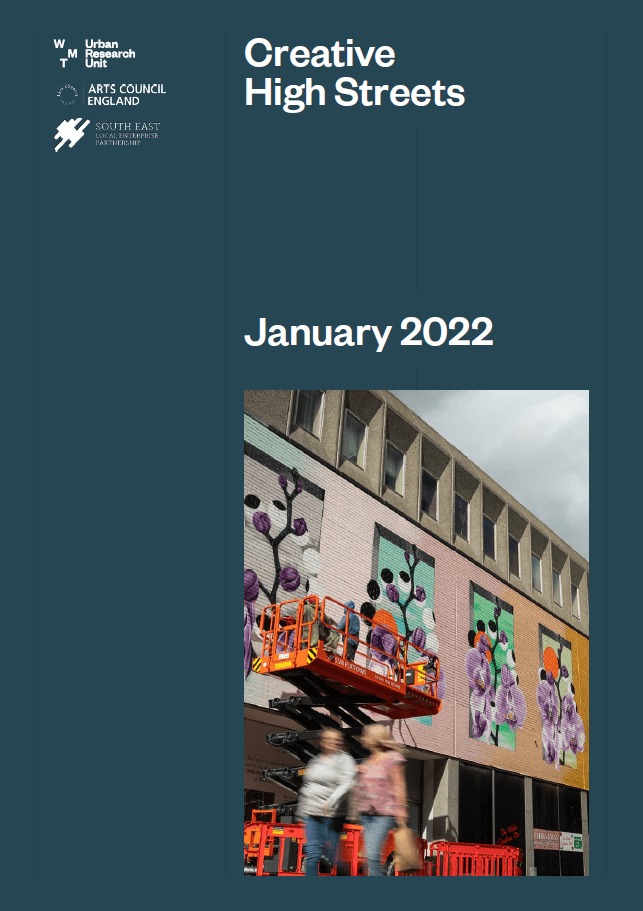The South East Local Enterprise Partnership (SELEP) and Arts Council England have joined forces to provide guidance on the clear, decisive action that can be taken by the cultural and creative sector to breathe new life into our high streets and kickstart a whole new economy for towns.
This work is more important now than ever in light of the COVID-19 pandemic, which has impacted both high streets and the creative sector particularly hard. The ongoing disruption for hospitality and retail also means that our high streets are in danger, and this kind of partnership working between organisations and businesses will be crucial to ensuring that our towns and communities flourish and prosper.
In the South East, a fifth of the region’s creative businesses are located within 200m of a high street, and 10% of high street businesses are working within the creative and cultural sector. Despite the turmoil this sector has experienced during the pandemic, 18% of start-ups and new businesses on high streets in the SELEP region were creative in 2020.
Roadmap to help local areas
The new Creative High Streets report provides a clear roadmap and practical guidance for any town in the South East, and speaks to all partners on how they can utilise the creative offering in their area to drive communities back onto the high streets. It highlights the unparalleled power of partnership working to drive true change and prosperity for local areas, despite the vast size of the South East and the diversity within the region.
The size and variation of the South East means that we are the region to pave the way for the rest of the country, showing how this boost to our creative sector and our high streets can be done with unmitigated success.
Across the region, high streets will have to be reconfigured to respond to a new reality and a different use of space and this will require a step change in the involvement of high streets and creative stakeholders – landowners, businesses, BIDs, public sector, third sector organisations – and communities. It will require all to be the active agents of change, sources of information, and to come together in a way that complements and plugs into the other agencies and agendas in play, including the critical investments of Arts Council England, the historic and emerging agendas of local governments, and the strategies of the creative and cultural sector itself.
The LEP also has a key role to play in the creation of innovative approaches to cultural development in the region, by using its leadership voice, and its investment capabilities, in a way that aligned with its core economic development purpose.
SELEP Deputy Chair Sarah Dance said:
“Enabling and developing strategies for High Street recovery has never been more important. In light of the impact of the COVID-19 pandemic on the economies of our towns in the South East, the challenges facing our High Streets have accelerated. Yet we have seen new ways of working and innovative ideas led by the creative sector that has begun to change this story.
“This report, jointly funded by SELEP and Arts Council England, presents a detailed evidence base and clear call to action for all stakeholders to take advantage of the growth opportunity for the creative sector in our High Streets. Our ambition is for this report to be a starting point for sustained action, leading to further funding opportunities and projects, and promoting the wider strategic ambitions of SELEP as articulated in the SELEP Economic Recovery and Renewal Strategy.”
Hazel Edwards, South East Area Director for Arts Council England, said:
“We are excited to welcome this report, jointly commissioned by SELEP and Arts Council England. The role that the cultural sector is playing in High Street regeneration up and down the country is already significant. This report helps to highlight some exciting and inspiring examples in the South East and is also invaluable in setting out strategies and practical steps which can be used to help facilitate regeneration through cultural activity.
“The range of ideas, the innovative practices outlined and the scalability of the activity all underline the practical and action-based nature of the report and we look forward to engaging further with High Streets across the South East over the months and years to come.”
Creative High Streets has been produced in conjunction with We Made That, which delivers urban research, strategies and masterplans, and public spaces and buildings with particular experience in high street regeneration, industry and workspaces, public spaces, cultural infrastructure, healthy neighbourhoods, public engagement and placemaking.
Holly Lewis, We Made That co-founding partner and national High Streets Task Force Expert, said:
“High streets need creative thinking more than ever at the moment. This report gathers practical learning from across the south east to showcase the myriad of ways that culture and creativity can help high streets to take their place at the heart of the region’s communities.”
Levelling Up in the South East
The Government’s recently published Levelling Up White Paper includes a pledge that states: “By 2030, pride in place, such as people’s satisfaction with their town centre and engagement in local culture and community, will have risen in every area of the UK, with the gap between top performing and other areas closing.”
This report can help translate this ambition into on-the-ground delivery. There are many exciting and entrepreneurial plans in the South East, and this report provides practical examples of how local areas can start on this journey and make a difference. We are committed to continue to work with communities across the South East to help make this happen.
The full report, and a recording of the recent webinar held to introduce the report, can be viewed here.
